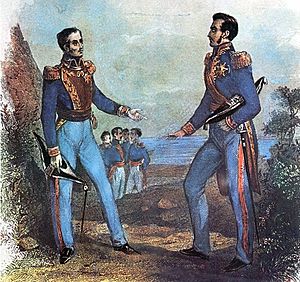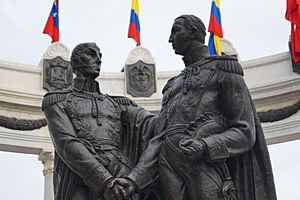Guayaquil Conference facts for kids
The Guayaquil Conference (Spanish: Conferencia de Guayaquil) was a very important meeting. It happened on July 26 and 27, 1822. This meeting took place in the port city of Guayaquil, which is now part of Ecuador.
The two main people at the meeting were two famous leaders: José de San Martín and Simón Bolívar. They were known as libertadors because they helped many South American countries become free from Spanish rule.
They met to talk about the future of Peru and all of South America. This conference was a big moment in the fight for independence in South America.
The main goal was to figure out how to finish the war for independence. Spanish royalist forces were still strong and trying to fight back. They also wanted to decide what would happen to the new independent countries. This was to make sure South America stayed free. Bolívar and San Martín had different ways of fighting for freedom. Bolívar's campaigns were very strict against the royalists.
Another important topic was who would control the Free Province of Guayaquil. Guayaquil was part of the Viceroyalty of Peru. It became free from Spanish rule in 1820. This happened because soldiers in the city rebelled. These soldiers were originally from Cuzco, Peru. After gaining independence, Guayaquil had strong ties with Peru.
Contents
Why the Conference Happened
The Importance of Lima
Lima, the capital of the Viceroyalty of Peru, was the most important city for Spain in South America. It was a strong base for the royalists. They fought hard against many groups trying to gain independence.
San Martín's Campaign
After Chile became independent, General José de San Martín built a navy. His forces used this navy to surround and capture Lima. Soon after, he declared Peru's independence. However, many royalist soldiers were still in the countryside of Peru.
Bolívar's Campaign
Simón Bolívar led another big fight for independence. He freed Venezuela after many tries. With help from Francisco de Paula Santander, he also freed the United Provinces of New Granada. This led to the creation of a large country called Gran Colombia. Battles like the Battle of Lake Maracaibo made sure Venezuela was truly free.
Guayaquil's Future
A revolt in Guayaquil led to the city's independence. Other cities in Ecuador followed. Neither San Martín nor Bolívar were involved in the very first part of the Ecuadorian War of Independence.
The people of Ecuador then debated what would happen to their region. Some wanted to join Gran Colombia. Others wanted to join Peru. And some wanted to form a completely new nation. Bolívar ended this discussion by adding Guayaquil to Gran Colombia. There was also pressure on San Martín from Peru to add Guayaquil to Peru.
What They Talked About

San Martín arrived in Guayaquil on July 25. Bolívar greeted him with great excitement. However, the two leaders could not agree on everything. They had common goals and respected each other. San Martín even offered to serve under Bolívar.
But they had very different ideas about how to govern the newly free countries. Bolívar wanted the new nations to be republics. A republic is a country where citizens elect their leaders. San Martín, however, preferred the European system. He wanted to set up monarchies, where a king or queen rules. San Martín even wanted to put a European prince in charge as King of Peru once it was free.
What Happened After
After meeting for several hours on July 27, San Martín stayed for a special dinner and dance. Bolívar made a toast to "the two greatest men in South America: General San Martín and myself." San Martín, in turn, toasted "to the quick end of the war; to the organization of the different Republics of the continent; and to the health of the Liberator of Colombia."
After the conference, San Martín went to Lima. There, he gave up his power in Peru to the new Peruvian Congress. He then returned to Argentina. Soon after, he left South America completely and lived in France.
Lasting Impact
The Guayaquil conference inspired a short story by Jorge Luis Borges. It was called Guayaquil and was published in his book El informe de Brodie (1971). In the story, he explores the possible thoughts and feelings between San Martín and Bolívar.
See also
 In Spanish: Entrevista de Guayaquil para niños
In Spanish: Entrevista de Guayaquil para niños


